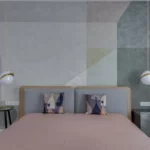Painting your home isn’t just about aesthetics; it’s also about creating an environment that affects your mood, emotions, and mental well-being. The colours you choose for each room can have a profound impact on your feelings, experiences, and overall tranquillity. This is a psychological fact that has been extensively studied and it goes much beyond personal preference or trends. In this blog, we delve into the science of colour psychology and how it applies to your interior house painting services.
The Psychology of Colour
Colour psychology is a branch of the broader field of behavioral psychology. The essence of this field is that our brain perceives colours and creates a corresponding hormonal response, which in turn affects our feelings and behavior.
For example, certain shades can evoke feelings of happiness or calm, while others may trigger excitement or agitation. It’s all about how specific wavelengths of light are interpreted by our brains. This is why the colour palette of your home is critical to establishing the mood and overall ambiance.
Bedroom: Your Sanctuary for Relaxation
The bedroom is your sanctuary – a place for relaxation, rejuvenation, and restful sleep. Calming hues like blues, greens, and light purples can help achieve a serene atmosphere.
White – White can bring a sense of peace and spaciousness to a bedroom, helping to create a clean and serene environment that’s conducive to rest and relaxation.
Blue – According to research, blue slows heart rate and reduces blood pressure, making it the ideal choice for bedrooms.
Green – Green is often linked with nature, providing a calming and rejuvenating effect.
Light Purple – While dark purple can evoke feelings of gloom and sadness, lighter shades such as lavender and lilac are known to lessen feelings of tension.
Kitchen: The Heart of the Home
The kitchen is the heart of the home – a place of creativity and vitality. Bright and cheery colours can stimulate appetites and energize the space.
White – White is a classic choice for kitchens. It’s associated with cleanliness and purity, making it a psychologically comforting choice for a space where food is prepared.
Yellow – Yellow can make a room feel sunny and bright. It’s been associated with happiness, and energy, and stimulates mental activity, making it a suitable colour for the kitchen.
Red – Red stimulates the appetite, which is why it’s used in so many restaurants and can be ideal for a kitchen.
TV Room: Fostering Relaxation and Focus
The TV room should be a place that promotes both relaxation and focus. It should be cozy and comfortable while enabling you to focus on the screen.
White – A TV room with white walls can provide a neutral backdrop, minimizing distractions while you’re watching television.
Dark Blue or Green – These colours can create a sense of deep relaxation, promoting focus on the screen.
Neutral shades – Neutral colours like beige, taupe, or gray can provide a balance, reducing strain on the eyes and preventing distraction from the main focus – the screen.
Living and Dining Rooms: Energizing Spaces
The living and dining rooms are areas where people gather, engage in conversation, and share meals. These rooms call for balanced colours that facilitate relaxation, conversation, and appetite.
White – White can be an excellent colour for living and dining rooms as it gives a sense of cleanliness and openness. It can also serve as a neutral backdrop, allowing other elements of the room, like furniture and artwork, to stand out.
Light Blue – Light blue is soothing, helping to calm heated discussions and promote peaceful interactions.
Soft Red or Terracotta – These colours stimulate conversation and appetite, making them ideal for a dining area.
The impact of colour psychology on our lives is profound, and harnessing this knowledge can allow you to design a home environment that promotes mental calmness and enhances well-being. Remember, these are general guidelines, but personal preferences and cultural influences can also play a significant role in how we perceive colours.
Our team at Fine Touch Painting company understands this science and art, and we’re always here to help you make the best colour choices for your unique needs. Let’s create a home that not only looks good but also feels right to you.
Contact us today to find out how we can help!
Sources:
- Elliot, A.J., Maier, M.A., Moller, A.C., Friedman, R., & Meinhardt, J. (2007). Color and psychological functioning: The effect of red on performance attainment. Journal of Experimental Psychology: General, 136(1), 154.
- Kwallek, N., Lewis, C.M., Lin-Hsiao, J.W., & Woodson, H. (1996). Effects of nine monochromatic office interior colors on clerical tasks and worker mood. Color Research & Application, 21(6), 448-458.
- Sutton, T., & Whelan, K. (2004). The complete color harmony. Rockport Publishers.
- Valdez, P., & Mehrabian, A. (1994). Effects of color on emotions. Journal of Experimental Psychology: General, 123(4), 394.
- Mehta, R., & Zhu, R. (2009). Blue or red? Exploring the effect of color on cognitive task performances. Science, 323(5918), 1226-1229.
- Spence, C., Puccinelli, N.M., Grewal, D., & Roggeveen, A.L. (2014). Store atmospherics: A multisensory perspective. Psychology & Marketing, 31(7), 472-488.
- Jonauskaite, D., Mohr, C., Antonietti, J.P., Spiers, P.M., Althaus, B., Anil, S., Dael, N. (2020). Most and least preferred colours differ according to object context: New insights from an unrestricted colour range. PLoS ONE 15(2): e0229198.
- Elliot, A.J., & Maier, M.A. (2014). Color psychology: Effects of perceiving color on psychological functioning in humans. Annual Review of Psychology, 65, 95-120.






